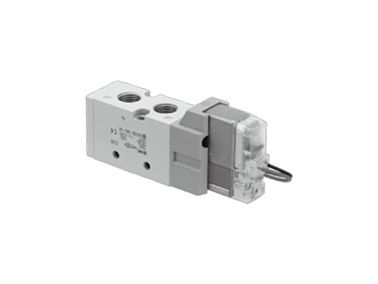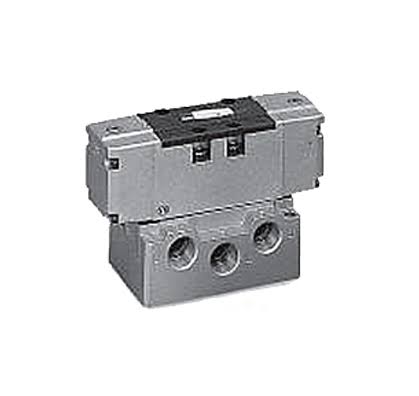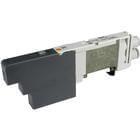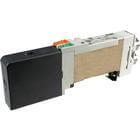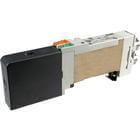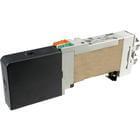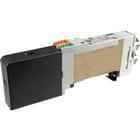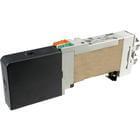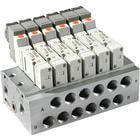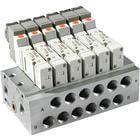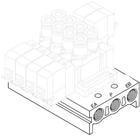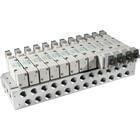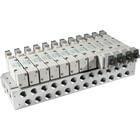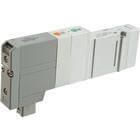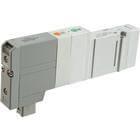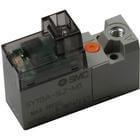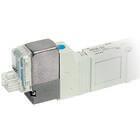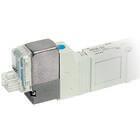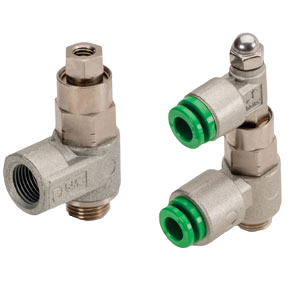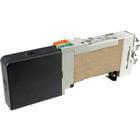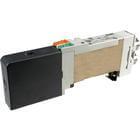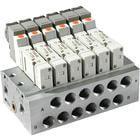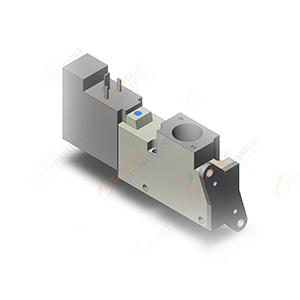SMC Pilot operated solenoid valves
IN STOCK!
5-port pilot operated solenoid valve
IN STOCK!!!
Valves
- Max operating temperature: 60 ° C
- Voltage - 220 V
- Power consumption: 2 W
- SQ1*3*
- 1000 Series
- 5 Port Solenoid Valve
- Plug-in Type (New Product)
- SQ2*3*
- 2000 Series
- 5 Port Solenoid Valve
- Plug-in Type (New Product)
- SQ2*3*
- 2000 Series
- 5 Port Solenoid Valve
- Plug-in Type (New Product)
- SQ2*3*
- 2000 Series
- 5 Port Solenoid Valve
- Plug-in Type (New Product)
- SQ2*3*
- 2000 Series
- 5 Port Solenoid Valve
- Plug-in Type
- SQ2*3*
- 2000 Series
- 5 Port Solenoid Valve
- Plug-in Type (New Product)
- SQ2*3*
- 2000 Series
- 5 Port Solenoid Valve
- Plug-in Type (New Product)
- SS5Y3
- 3000 Series
- Bar Stock Manifold
- Individual Wiring
- SS5Y3
- 3000 Series
- Bar Stock Manifold
- Individual Wiring
- SS5Y3
- 3000 Series
- Bar Stock Manifold
- Individual Wiring
- SS5Y5
- 5000 Series
- Bar Stock Manifold
- Individual Wiring
- SS5Y7
- 7000 Series
- Bar Stock Manifold
- Individual Wiring
- SS5Y7
- 7000 Series
- Bar Stock Manifold
- Individual Wiring
- SS5Y7
- 7000 Series
- Bar Stock Manifold
- Individual Wiring
- SSQ2000-P
- Individual SUP Spacer Assembly for SQ2000
- SV1000
- 5 Port Solenoid Valve
- All Types
- SV1000
- 5 Port Solenoid Valve
- All Types
- SY100
- 3 Port Direct Operated Valve
- Rubber Seal
- SY3000-26
- Blanking plate for SX3000
- Type 20(P/N) - 41(P/N) - 42(P/N)
- SY3000
- Blanking Plate Assembly
- SY3000
- 5 Port Solenoid Valve
- All Types
- SY3000
- 5 Port Solenoid Valve
- All Types
- SQ2*3*
- 2000 Series
- 5 Port Solenoid Valve
- Plug-in Type
- SQ2*3*
- 2000 Series
- 5 Port Solenoid Valve
- Plug-in Type (New Product)
- SS5Y3
- 3000 Series
- Bar Stock Manifold
- Individual Wiring
| Fluid | air, inert gas |
| Effective area | 2 mm Cv |
| Operating pressure range | 0.1 - 0.7 MPa |
5-Port Solenoid Valve
SMC is a global pneumatic and electrical automation equipment manufacturer, including a wide range of solenoid valves. Solenoid operated valves are electromechanically operated valves used to control the flow of various types of fluids, such as gases or liquids, through a system or process. These valves are commonly used in industrial automation, manufacturing, and other applications where precise control of fluid flow is required. We will discuss pilot operated solenoid valves in more detail below.
Overview of SMC Pilot Operated Solenoid Valves
SMC pilot operated solenoid valves use the differential pressure of the medium in the valve holes to open and close them. They are also known as servo solenoids which provide high flow rates and can operate over high pressure and temperature range with less power consumption.
Servo pilot operated pneumatic control valves use a small chamber directly above the diaphragm to facilitate valve operation. Process fluid enters the chamber through a small opening in the inlet port and a normally closed valve.
Compressing the diaphragm exerts pressure on the seat, ensuring a tight seal. As soon as the current is applied to the pilot, the diaphragm rises against the pressure of the spring; this forces the pilot fluid back through the orifice to recombine with the main flow through the valve body.
The main applications for pilot operated diaphragm solenoid valves are liquid or gaseous media (e.g., compressed air, water, and hydraulic oils) in closed circuits with little or no pressure difference to open and close.
Working Principle of SMC Pilot Operated Solenoid Valves
The SMC pilot solenoid valve operates as follows. If there is no voltage, then the plunger of the e/m coil blocks the discharge channel. Liquid, vapor, or gaseous content through the bypass channel penetrates the cavity above the membrane. The same pressure is maintained in the holes above and below the membrane. Due to downward pressure on the larger membrane plane, the resulting force is also oriented downward. Firmly pressing the diaphragm against the seat ensures the central orifice is covered.
When power is applied to the coil, the upwardly retracting plunger opens the reset channel. The contents from the cavity above the membrane through this channel enter the valve outlet. A pressure drop in the pit above the membrane directs the final force upward. The membrane is lifted, and the central opening opens, passing the contents from the inlet to the outlet.
Regular valve operation requires a minimum pressure drop between the inlet and outlet ports. This parameter is given in the technical documentation attached to the device and varies in the 0.1-0.9 bar range. The advantage of indirect-acting solenoid valves is increased flow capacity with low energy consumption.
Role of Solenoid Coil and Plunger in Valve Operation
Solenoid operated pilot valves have two main parts: a solenoid (or electromagnet) and a valve. The valve body consists of two or more holes. A solenoid consists of several essential elements, including the coil, bushing assembly, and plunger.
Solenoid valves work using an electromagnetic coil that opens or closes a valve opening. When the coil inside the solenoid is energized, the plunger rises or falls, opening or closing the orifice. This controls the flow by regulating the movement of the gas or liquid.
Advantages of SMC Pilot Operated Solenoid Valves
Choosing a SMC pilot operated solenoid valve for a particular application offers several significant advantages, the main ones being.
- Quick response - solenoid valves have a high opening and closing speed, allowing you to instantly adjust the flow of the working medium, which is especially important in systems that require precise control and instant response;
- High reliability - such mechanisms have a simple design with a small number of moving parts that can work without failure for an extended period and withstand intense working conditions;
- Wide range of working environments - versatility is achieved due to the simplicity of the device and the use of wear-resistant materials that are not exposed to liquids and gases and are also protected from low and high temperatures;
- Energy saving - products require a small amount of energy to operate since they can only be opened or closed when an electrical signal is applied, which contributes to significant resource savings;
- Precise flow control - solenoid valves provide a high degree of control over fluid flow and can be set to the desired pressure and open/close times, which is especially important in systems where prudence is needed;
- Possibility of automation - devices are easily integrated into automation and control systems and can work in conjunction with sensors and controllers to automatically control the flow of the working environment based on specified parameters;
- Wide choice - products are available in various configurations, sizes, and specifications, allowing you to choose the best solution for specific needs and operating conditions.
Thus, choosing a solenoid valve offers several benefits, including fast response, durability, cost efficiency, energy savings, and the ability to accurately control fluid flow, making them a popular choice in many industries and industries.
Factors to Consider when Choosing Pilot Operated Solenoid Valves
When choosing a solenoid valve, you need to know what type of medium it will be used for. As a rule, solenoid valves are designed to work with media without solid particles, such as water, oil, petroleum products, steam, compressed air, or heat transfer fluids. This critical information lets you determine the materials your solenoid valve will be made from. Most solenoid valves are made of brass (ideal for water, fuel, air, or inert gas), stainless steel (for corrosive liquids or gases, food), or plastic (mainly in the food and chemical industries).
We recommend using an inlet filter before the solenoid valve to avoid any malfunction due to the presence of solid particles, also called impurities.
Solenoid valves can be two-way or have multiple ports. Two digits usually define them. One specifies the number of ports, and the other the number of positions. For example, a 3/2 solenoid valve has three ports and two positions.
Most solenoid valves operate in an on or off (open or closed) mode, and some are designed to be proportional to supply current or voltage.
Depending on your application and to optimize the delivery time of your solenoid valve, you have the choice between customarily closed (NC) solenoid valves and normally open (NO) solenoid valves:
- A normally closed solenoid valve opens when powered by electricity.
- A normally open solenoid valve closes when it is energized.
You can also choose a bistable solenoid valve whose flap remains in place even during a power failure. The main advantage of these solenoid valves is that they consume very little energy.
Solenoid valves are usually sensitive to moisture. You must check the ambient conditions to select a solenoid valve with sufficient protection (IP) for the intended environment. You can also choose a lower protection class and install the solenoid valve remotely in a less humid location.
Solenoid valves are also defined by nominal diameter (DN) as they are built directly into the circuit. Standards determine connection and pipe diameters according to the country or geographic region in which they will be used and the environment in which they will be used.
Solenoid valves may also be subject to other standards, such as those governing equipment installed in ATEX (atmosphere hazardous) areas, especially for the energy industry.
Comparison with Other Solenoid Valve Types
Pilot solenoid valves use the pressure difference between the inlet and outlet media to open and close. As a result, it can only be used in one direction. In this case, the coil is used to signal to open or close. This does not require a lot of electricity. On the other hand, this type of solenoid valve is used in high-flow systems to ensure that the pressure difference between the inlet and outlet of the solenoid valve is sufficient to operate it.
A direct-acting solenoid valve does not require a differential pressure to operate because the coil acts directly on the diaphragm or valve, but this may require a large amount of electricity. This solenoid valve type is used for low flow rates with pressures varying from 0 bar to the maximum circuit pressure.
If you want to learn more about pilot operated solenoid valves from SMC then please contact our qualified managers who will be happy to answer all your questions. In addition, Eltra Trade is always ready to provide you with any SMC products that are in our catalog.
